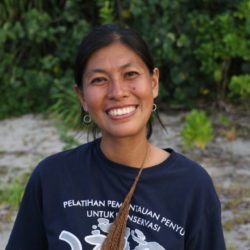
Deasy Lontoh
Leatherback Turtles: Ancient Mariners of the Pacific
About the Speaker
Deasy lives in Manokwari, West Papua and has been working with leatherback sea turtles nesting in the Bird’s Head peninsula of Papua since 2010, when she was a graduate student. In 2014 she received her master’s degree in marine science from Moss Landing Marine Laboratories located in Monterey Bay, California. For her thesis, she studied the productivity of Bird’s Head leatherback turtles that foraged in different regions of the Pacific Ocean. Currently she is working under the State University of Papua’s Research and Community Service Division to monitor the leatherback population, increase hatchling production through nesting protection and conduct scientific research that supports leatherback conservation. She is part of a dynamic team that focuses not only on helping the leatherbacks but also empowering the local community. Last year Deasy and her team produced over 60,000 leatherback hatchlings, involved over 30 community members at the nesting beach and helped 54 community members earn additional income by teaching them how to produce high-quality coconut oil and traditional knitted bags. Talk Overview: Leatherback turtles are great ocean voyagers. Their annual migration is one of the longest of any animal. After laying eggs at the Bird's Head peninsula of West Papua, leatherbacks migrate thousands of miles across the Pacific to feed. They are regular visitors to the U.S. West Coast, where they take advantage of abundant jellies between July and October. One of the last strongholds for Pacific leatherbacks is the northwest coast of the Bird's Head peninsula, West Papua, Indonesia, specifically at Jamursba Medi and Wermon beaches. Each year, these two beaches are the site of approximately 75% of nesting activity in the western Pacific. To protect these critical nesting habitats, the Tambrauw regency government established the Jeen Womom Coastal Park in 2015. Although considered the Pacific’s healthiest population, the Bird's Head leatherbacks have declined by approximately 78% due to large-scale egg harvesting between 1970s and 1990s by indigenous communities living near the nesting beaches. Although illegal egg harvesting has now ceased, low hatching success has slowed population recovery. Deasy leads the nesting beach program for the State University of Papua (UNIPA), which has been spearheading research and conservation in the Coastal Park since 2005. With the help of local community members, her team has been working to increase hatching success by protecting turtle nests. In addition to their work on the nesting beaches, the UNIPA team engages in a community empowerment program. This program has successfully increased community buy-in for leatherback conservation, raising awareness of the importance of protecting marine turtles, and bringing more support to the nesting beach program. Deasy will share some of the lessons learned in promoting lasting and comprehensive marine turtle conservation in the region.